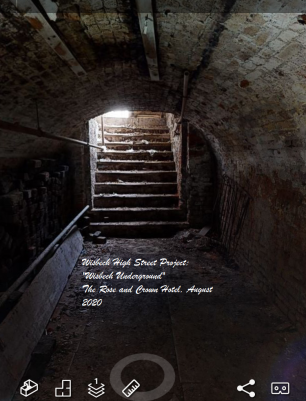The Rose and Crown
To take a virtual tour and explore the cellars beneath the Rose and Crown, follow this link
To take a virtual tour and explore the storage vaults beneath the hotel car park, follow this link
Summary by Mark Gardiner and Phillipa McDonnell, University of Lincoln
The following has been extracted from a report on all three locations surveyed by the University of Lincoln in 2020.
The Rose and Crown hotel is a Grade II* listed building located on the west side of the Market Place, Wisbech. It has plaster work in the rear range with a date of 1601, with a gallery which overlooks the courtyard. The elevation facing the Market Place was rebuilt in the mid-nineteenth century.
The history of the Rose and Crown can be traced in outline from trade directories. In 1839 it was run by Richard Goddard, who was, however, not listed amongst the wine merchants of the town. A relation, Ann Goddard, is recorded as running the hotel in 1851 when she was listed also amongst the wine and spirits merchants in her own right and as an agent for ‘Walker and Walton’s British wines’. The hotel was apparently taken over in 1857 by William Tidnam, who was described in 1879 as a wine, spirit, ale and porter merchant. He continued to run the business until his death c.1904, after which it was taken over by Henry August Tidnam. The wine and spirit merchants of H. A. Tidnam’s survived until 1957 when it was taken over, but by then the family had long relinquished their interests in the Rose and Crown, which was sold in 1932.
The development of the cellars is likely to reflect the developing interest, first by the Goddard’s in the drinks trade around the middle of the nineteenth century and later in the commercial activity of William and Henry Tidnam. While this was at first an adjunct to the business of inn-keeping, it later became a commercial venture in its own right.
While the earliest part of the cellars, “Rooms” 1 and 2, may date to the later fourteenth or fifteenth centuries, the expansion of underground storage took place in the mid- and late nineteenth century, possibly after it came into the ownership of William Tidnam. While the foundations for the trade as wine and spirit merchants had been laid by the Goddard’s, it evidently grew in the second half of the century. “Room” 7 may have been built around the middle of the nineteenth century, as perhaps was “Room” 3. Further cellars were added to these and the whole linked by “Room” 6 which was constructed under the carriageway. The cellarage was much greater than that required for a simple hotel and is a material evidence of the progressive movement of the Tidnam’s towards the wider wine and spirit trade and away from simply keeping hotels. However, the importance of the cellars under the Rose and Crown are less significant than the much larger cellars established beneath Bridge Street.












No Comments
Add a comment about this page